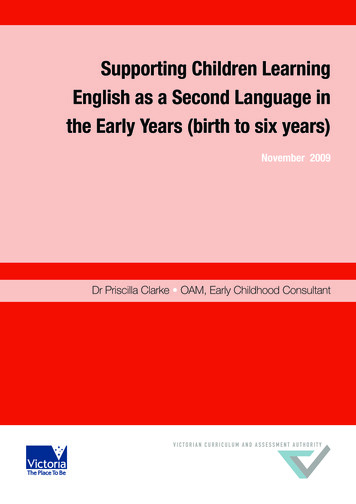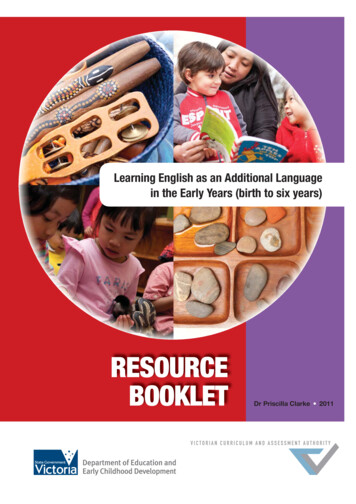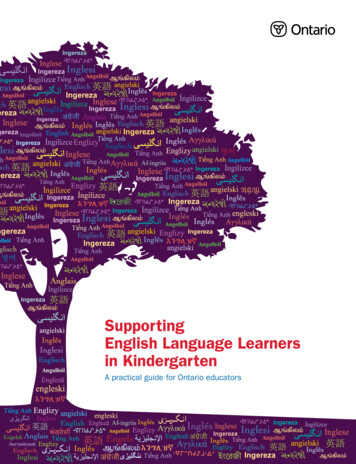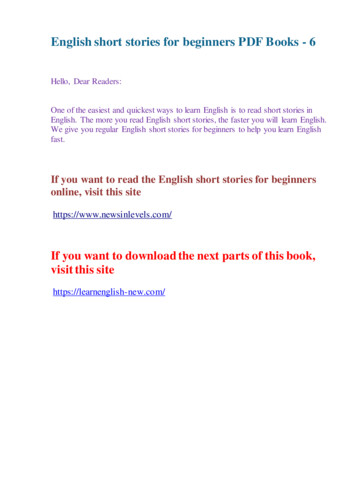
Transcription
Supporting Children LearningEnglish as a Second Language inthe Early Years (birth to six years)November 2009Dr Priscilla Clarke OAM, Early Childhood Consultant
This Discussion Paper was commissioned by the VCAAas a supporting document to the Victorian Early YearsLearning and Development Framework, 2009. Victorian Curriculum and Assessment Authority 2009No part of this publication may be reproduced except as specified under theCopyright Act 1968 or by permission from the VCAA. For more informationgo to: ght.htmlThe VCAA provides the only official, up-to-date versions of VCAA publications. Details of updates can be found on the VCAA website:www.vcaa.vic.edu.auThis publication may contain copyright material belonging to a third-party.Every effort has been made to contact all copyright owners. If you believe thatmaterial in this publication is an infringement of your copyright please emailthe Copyright Officer c/o: ght in materials appearing at any sites linked to this document restswith the author of those materials, subject to the Copyright Act. The VCAArecommends you refer to copyright statements at linked sites before usingsuch materials.ISBN 978-1-921702-17-4
Dr Priscilla Clarke, OAM wasformally Executive Directorof FKA Children’s Services,which includes the MulticulturalResource Centre. She is currentlyan early childhood consultantspecialising in the Second Languageacquisition of young bilingualchildren. Priscilla has conductedprofessional development for earlyyears professionals in Australia,New Zealand, Thailand, England,Scotland, Northern Ireland andIreland. She is the author of manypublications including a bookwritten jointly with Professor IramSiraj-Blatchford and published byOpen University Press.In 2003, Dr Clarke was awardedan Order of Australia Medal forher significant contribution to thebilingual preschool education ofimmigrant and refugee children.3
Supporting Children Learning English as a Second Language in the Early Years (birth to six years)ContentsBackground and purposeIntroductionRelationship with the Victorian Early Years Learning and Development Framework (VEYLDF) birth to eight yearsWho are learners of English as a second language?The importance of language for young childrenPartnerships with parentsThe importance of maintaining the first or home languageWhy is it important to be bilingual?Maintaining the first language in children under threeMaintaining the first language in years prior in children age three to six yearsLearning English as a second or an additional languageBabies and toddlersChildren in the years prior to schoolIdentity and wellbeingDo children need to be fluent in English before going to school?Children new to English in the early years of schoolStages of ESL development for children in the years prior to entering school and the early years of schoolThe importance of oral English language developmentStages of second language acquisitionUse of the home languageOral English language development – an overview of stages between three to six years of ageStage 1 – New to EnglishStage 2 – Becoming familiar with EnglishStage 3 – Becoming a confident user of EnglishStage 4 – Demonstrated competency as a speaker of EnglishRates of acquisitionProvision of inclusive environmentsImportance of playThe role of early childhood professionalsDeveloping listening skillsUse of contextualised languageUse of decontextualised languageSupporting language comprehension and productionSustained shared communicationAssessing outcomesAchieving outcomesLanguage delayAppendix 1Resources and supportBooks, CDs and resources reflecting diversity of culture and languageReference material for early childhood professionalsAppendix 2References and further 222222424242424252526272828292930305
Supporting Children Learning English as a Second Language in the Early Years (birth to six years)6Background and purposeIntroductionThe Victorian Early Years Learning and DevelopmentFramework (VEYLDF) (Victorian Framework) birthto eight years, has been developed in partnership withthe Office for Children and Portfolio Coordination,Department of Education and Early Childhood Development (DEECD) and the Victorian Curriculumand Assessment Authority (VCAA). The VEYLDFwas launched November 2009 for implementation in2010.The Victorian Framework describes five Learningand Development Outcomes for children from birthto eight years. It links the learning outcomes from theEarly Years Learning Framework for Australia to theVictorian Essential Learning Standards (VELS) Levels 1 and 2. The Outcomes provide a shared languagefor all early years childhood professionals and families to use when planning for children’s learning anddevelopment.This document, Supporting Children LearningEnglish as a Second Language in the Early Years(birth to six years) is the first in a series of Implementation guides designed to support families and earlyyears professionals . It has a particular focus on children in the three to six years age group and supportschildren’s transition into school.The Victorian Framework recognises that children’s learning and development takes place in thecontext of their families and that families are children’s first and most important educators. Familiesprovide children with the relationships, the opportunities and the experiences which shape their learningand development.The Victorian Framework acknowledges that thefamilies and communities in which children live arediverse; and that children’s learning and developmentis enhanced when they experience relationships withearly childhood professionals that respect their culture and ways of knowing and being. In particular theframework recognises and respects Aboriginal andTorres Strait Islander cultures and the unique placeof these as a valued part of Victoria’s heritage andfuture. Learning about and valuing the place of firstnations people will enhance all Victorian children’ssense of place in our community.The Victorian Framework recognises that everychild will take a unique path to the five Learning andDevelopment Outcomes. Children will require different levels of support, some requiring significantlymore than others.In Australia at the present time there are many children starting kindergarten or child care for whomEnglish is not their first or home language. Someearly childhood settings have a diversity of languagesspoken, while others have only one or two childrenwho do not speak English. Early childhood professionals working with these children need to ensurethat the support they provide benefits all the childrenin their program.The five Learning and Development Outcomes inthe Victorian Early Years Learning and DevelopmentFramework (VEYLDF) birth to eight years are accessible to all children. However, the pathways to theseoutcomes will vary for different learners. This document provides information about the second languagelearning development of young children from birthto six years of age and intersects with the advice offered in the Victorian Essential Learning Standards(VELS), English as a Second Language (ESL) companion.Honouring diversity, respecting and promoting theuse of languages other than English and also ensuringall children acquire English as a second language, isfundamental to securing the rights of all children toan early childhood program that meets their needsand provides them with educational and social outcomes that assist them in attaining a high standard ofeducation and a responsible life in the future.Cultural and linguistic diversity has been a feature of Australia for more than 40 000 years. Prior tocolonisation currently more than 250 Indigenous languages were spoken throughout Australia. The VEYLDF recognises family diversity and children’s rightsto maintain their culture, language, faith, religion andspirituality.
Supporting Children Learning English as a Second Language in the Early Years (birth to six years)Relationship with the VictorianEarly Years Learning andDevelopment Framework(VEYLDF) birth to eight years The recognition of the role of parents aseducators in their children’s development is vital.The Victorian Framework strengthens children’slearning and development in the critical years of early childhood. It identifies what children should knowand be able to do from birth to eight years of age.It recognises that children’s first and most importantlearning happens in the family. It supports partnerships between families and all professionals who areresponsible for a child’s learning and developmentduring this time.The five Victorian Learning and DevelopmentOutcomes in the VEYLDF relate to: children have a strong sense of Identity (Identity)Who are learners of English as a secondlanguage? children are connected with and contribute totheir world (Community) children have a strong sense of wellbeing(Wellbeing) children are confident and involved learners(Learning) children are effective communicators(Communication).The Victorian Framework will ensure that the specific learning and development needs of children fromculturally and linguistically diverse backgrounds aremet through the inclusion of the following key considerations: Bilingualism is an asset. It is important tomaintain the children’s first or home languagesas this has a significant role in shaping identity,language development and increased cognitivedevelopment. Continued development of first or homelanguages gives the children access toopportunities for learning in the early years bybuilding on knowledge and competencies that thechildren have already developed. Secure and trusting relationships betweenchildren and early childhood professionals,including those who speak languages other thanEnglish, are essential for children to feel valuedand accepted in all early childhood settings. It is important for early childhood professionalsto understand the stages of first and secondlanguage development in children.Maintenance of the first language and progress inlearning English as a second language are essentialpathways for children in achieving the outcomes.Learners as individuals will follow different pathways to achieving these outcomes.Standard Australian English is the national languageof Australia and it is essential that all children growing up in Australia have access to opportunities tobecome proficient speakers of English. Children whoare learning English as a second (or additional language) speak a language other than English and bringrich and diverse cultural and linguistic knowledge tothe early childhood and school settings.In Victoria children learning English as a secondmay be children of immigrant heritage born in Australia and other English-speaking countries and children born in a non-English speaking country.Children learning English as a second languageare a diverse group. Some children will have had littleor no exposure to English when starting child care,family day care, kindergarten or school. Other children will have been exposed to English through oldersiblings, child care or playgroup experiences or willhave been introduced to some English at home. Somevery young children will still be acquiring their firstlanguage at home, while learning English as a secondlanguage in child care or family day care.Children learning English as a second languageneed explicit modelling and language teaching, appropriate time to acquire the new language and quality exposure to English. This requires early childhoodprofessionals to be knowledgeable about the waychildren learn a second language, the stages of acquisition and the recognition that children differ in theirrate of acquisition.Children from language backgrounds other thanEnglish vary in their linguistic preferences. It is important not to assume that children who come fromhomes where English is not the main language willspeak only their first language in the home. Some bilingual parents may choose to speak English at home.However, it is essential that parents understand thebenefits of maintaining their first language and feelconfident in speaking their language at home, if thisis what they choose. It is a right enshrined in the Convention on the Rights of the Child (Article 30, 1990)to maintain the first or home language.7
Supporting Children Learning English as a Second Language in the Early Years (birth to six years)8The importance of language for youngchildrenPartnerships with parentsThe early years are recognised as the foundationyears for children’s development. In particular, thefirst six years are crucial for young children in developing their first language and cultural identity, andit is during these early years that children build uptheir knowledge of the world around them. For children from language backgrounds other than English,the language or languages of the home that have beenused since birth are the basis for developing meaningful relationships and learning about meaningfulcommunication and interaction (Siraj-Blatchford andClarke 2000).‘Language is the most powerful tool in the development of any human being. It is undeniably thegreatest asset we possess. A good grasp of languageis synonymous with a sound ability to think. In otherwords language and thought are inseparable’ (Vygotsky 1986). Language has a major role in supporting children’s process of identity formation and inhelping them understand where they fit in the newenvironment they are entering. The acquisition oflanguage is essential not only to children’s cognitivedevelopment, but also to their social development andwellbeing.For young children interaction with adults and other children is the key to the acquisition of language.For infants and toddlers their early interaction withparents and caregivers provides the basis for communication and learning in both the first or home language and in the second language (Siraj-Blatchfordand Clarke 2000).The importance of links between home, and earlychildhood settings or school is widely recognised.Parents need to participate in both the developmentof the educational program and its implementation.When children and parents start the program, theybring with them a wealth of cultural, linguistic andeconomic experience which the early childhood professional can draw upon.Strong partnerships with parents are essential, ifchildren learning English as a second language areto have positive outcomes in the early childhood setting. Partnerships with parents are primarily aboutequity. In supporting families from culturally andlinguistically diverse backgrounds, early childhoodprofessionals take responsibility to ensure fairnessand build dynamic relationships that create a sense ofbelonging for all.In early contacts with a family, early childhoodprofessionals learn as much as they can from parentsabout the home environment, languages spoken athome, other family members etc, important culturaland religious factors, food preferences, taboos andother cultural information that is relevant to building up a profile of the child, the family and the community. This also includes finding out what nameis used for the child at home, and using the correctpronunciation of the child’s and the parents’ names Itis both important and reassuring for parents to knowthat the use of the child’s home or first language willsupport the child’s development in English (Clarke1992). Translated materials on the value of maintaining the first language are available in both written andrecorded forms from FKA Children’s Services (Appendix 1).It is important that early childhood professionalsestablish meaningful dialogue with parents and wherever possible, that information is communicated inthe first language of the family using qualified andaccredited interpreters, not bilingual aides, assistantsor other parents. Parents need to be kept informed oftheir children’s progress in learning English, and, atthe same time, of their right to maintain their first language at home. Sensitive information should alwaysbe gathered using interpreters (Appendix 1). It is alsoimportant to gain parental permission before passingon any information to a third party. This includes transition reports, when children move from child care topre-school, or from pre-school to school.
Supporting Children Learning English as a Second Language in the Early Years (birth to six years)Parents can be encouraged to take an active partin the early childhood program. This should involvemore than just coming to prepare fruit or washingthe towels and smocks. True participation builds onpartnerships with parents and communities and encompasses respect, negotiation, a sense of belonging,compromise, communication and realistic expectations. Some parents will be happy to join in the educational program, as they can speak to the childrenin their first language, or share music and culturalaspects. Other parents may not wish to participate inthis way, either through lack of time or cultural unfamiliarity. It is important that early childhood professionals accept the level of participation that familieswish to offer.Early childhood professionals play an importantrole in assisting parents to understand the VictorianEducation system. ‘The transition to school is an experience that starts well before and extends far beyond the first day of school’ (Morand 2009). Whenworking with parents from culturally and linguistically diverse backgrounds there are different strategies and approaches that can be used.In Term 2, in one inner city kindergarten, bilingualsessions for parents are held to discuss enrolments forschool the next year. At these sessions, the differenttypes of schooling available in Victoria, public andprivate are discussed and the procedures for enrolling and visiting are given. Later in the year, the localschools provide information to the kindergarten detailing when children can enrol, these are distributedto all families and include the information on Transition; A Positive Start to School Guide Department ofEducation and Early Childhood Development. 2009The importance of maintainingthe first or home languageOne of the greatest gifts we pass on to children islanguage. The first language, learned in the home, isextremely important and forms the foundation for alllater language development. Parents, family membersand early childhood professionals are the most significant influences on the development and maintenanceof the first language (Clarke and Milne 1996).Evidence shows that young children can learnmore than one language with ease, as long as theyare exposed to good language models and have plentyof exposure to both languages. Maintaining the firstlanguage does not interfere with the learning of English. Research suggests the opposite – that knowingone language can help the child understand how otherlanguages work. The maintenance of the first or homelanguage is particularly important for the child’s development of a positive self-concept and well-being.Children who have the opportunity to maintaintheir first language can extend their cognitive development, while learning English as a second language.Their level of competence in the second languagewill be related to the level of competence they haveachieved in their first language (Cummins 1984).Children with a sound knowledge of their first language will be able to transfer skills from one languageto another.Early childhood professionals can play a vital rolein the maintenance of children’s first languages. Theycan provide opportunities for children to use their firstlanguage in early childhood settings and at schooland encourage the parents to use the first language athome in order to provide a good foundation for learning English. It is important to reassure parents thatchildren will learn English as a second language fromEnglish speakers.Why is it important to be bilingual?Bilingualism is the ability to use two languages, andinvolves both understanding and speaking, not necessarily with the same degree of fluency, but in eitherlanguage. For example, young bilingual children mayuse only their first language at home and use onlyEnglish in the early childhood setting or school. Somechildren may use their home language with certainadults in the family, while using English with otheradults and with their siblings. Some children may feelcomfortable using both languages in the same setting9
Supporting Children Learning English as a Second Language in the Early Years (birth to six years)and may ‘switch’ from one to the other easily (SirajBlatchford and Clarke 2000).There is now widespread recognition of the social, personal and cognitive benefits of bilingualism:a sound foundation in the language/s of the homeincreases children’s self-esteem and confidence,enhances motivation for learning, increases cognition, strengthens family relationships and provides astrong basis for learning the second language (Cummins 1984, Clarke and Milne 1996). Over 70 per centof the world’s population speaks more than one language. Thus for many children it is as natural to growup speaking more than one language as it is to growup speaking one.Children under six years of age are still in the stages of acquiring their first language. However, by threeyears of age, they have achieved much of the development of spoken language. Many children at thisage are already fluent in their home language, whichprovides a sound basis for learning English as a second language. By this time children have knowledgeof language and how it works. They are practiced incommunicating with others and will transfer theseskills to the learning of their second language.Two types of second language acquisition havebeen described: ‘simultaneous acquisition’ and ‘sequential or successive acquisition’. ‘Simultaneous acquisition’ occurs when children are exposed to morethan one language from an early age, for example,when parents speak different languages, or when ababy starts in a children’s service and is exposed onlyto English, but speaks only a language other thanEnglish at home. ‘Sequential or successive acquisition’ occurs when children begin to learn the secondlanguage when the first language is partially established, for example, when children start in the nurseryor school (Siraj-Blatchford and Clarke 2000, p. 29).There are many reasons why it is important to support the continued learning of the home language ormother tongue, for example: a strong first language supports the developmentof a positive self-concept speaking the first language well helps strengthenrelationships within the family continuing to speak the first languageprovides the opportunity to continue cognitivedevelopment while learning English as a secondlanguage.10In supporting the first language development ofyoung children, early childhood professionals needto: respect and support the home language/s of thechildren ensure that the children’s cultural background isincorporated into the program base their planning on current knowledge oflanguage development create an environment which supports naturallanguage learning and interaction closely observe children talking in a variety ofsituations to find out what they know and toaccess their skills in using language establish a supportive environment which affirmschildren’s right to use languages other thanEnglish understand and appreciate the home literacyenvironments of the children assist parents to understand the value of a strongfirst or home language.Maintaining the first language in childrenunder threeFor children under three years of age who are entering a children’s service, the maintenance of the first orhome language is critical. Between the ages of twelveand eighteen months many babies can produce firstwords or units of language. Babies who start in a language environment different from the home will alsostart learning single words in English. As in the development of their first language, children will learnfunctional words such as ‘no’, ‘mine’, ‘bye-bye’. Parents need to be supported to feel comfortable usingtheir own language at home.In an ideal child care setting, babies and toddlerswould hear their own language for most of the time.However, this is often not possible. Since this is thecrucial time for developing language, early childhoodprofessionals, parents and caregivers need to providesupport for young learners through direct, personalcommunication. If bilingual staff are available theyare a valuable resource for working with childrenunder three as this is a crucial time for learning language. Babies learn about language long before theysay their first word. They learn to listen and discriminate among different speech sounds and enjoy hearing a variety of sounds. They are strong communicators from a very early age and respond to the voiceof their caregiver. They turn to look for the familiar
Supporting Children Learning English as a Second Language in the Early Years (birth to six years)person when they hear them talking. They smile atthe sound of a favourite voice, they coo and babblewhen spoken to (Bruner 1983; Milne, Orzeszko et al.1994).Babies need to hear their own language as well asEnglish. It is not always possible to employ bilingualstaff. However, other strategies can be used. Earlychildhood professionals can: learn and sing songs in languages other thanEnglish learn simple rhymes play CDs with simple songs and rhymes inLanguages other than English (LOTE) ask parents to stay for a few minutes to sharesomething of their language with their own andother children ask parents to record songs from their culture. listening to stories on CDs in languages otherthan English learning skipping and counting games inlanguages other than English. asking parents to teach games and words in otherlanguages providing bilingual story books writing children’s names in other languages learning singing games in different languages.Ask the parents if they can teach some; aska bilingual worker to teach games from theircultures accessing computer programs in languages otherthan English for games and activities finding bilingual websites and websites withgames, stories and songs.Early childhood professionals can also activelyencourage parents to use their first language at alltimes and to make opportunities for engaging theirbabies and toddlers with lots of language. There are anumber of bilingual playgroups established throughout Victoria. These provide excellent opportunitiesfor parents to support the learning of languages otherthan English through a play based approach. Contactthe Playgroup Association for further information www.playgroup.org.au .Maintaining the first language in yearsprior in children age three to six yearsThere are many fun ways of learning other languages. The best way is to surround children with naturallanguage use in play, in conversations with adultsand other children, in songs and games, stories andrhymes. All children can learn the meaning of wordsin other languages.Ask parents to assist by speaking to children intheir first language, teaching songs and rhymes, helping with small group experiences such as cooking,and talking in their own language during group timessuch as puzzles and block play. Utilise bilingual earlychildhood professionals, students or volunteers, whocan provide quality time for children speaking in theirfirst languages.Games and activities for maintaining the first language include: playing picture lotto, bingo and card games,using two languages or playing in a languageother than English11
Supporting Children Learning English as a Second Language in the Early Years (birth to six years)Learning English as a second oran additional languageBabies and toddlersWhen babies and toddlers from language backgroundsother than English start in a children’s service, theybegin the process of learning a second or additionallanguage. From birth, they will have started to acquire their first language. This first language is learntthrough contact with family members and others inearly communication that includes talking, singing,cooing, making sounds and engaging in non-verbalcommunication. It is vital that early childhood professionals working with young children promote thecontinued use of the first or home language and encourage families to spend as much time as they cantalking with their young children. When English isadded as a second language, much of the opportunityfor many young children to hear and practise theirfirst language may be diminished.During the first three years of life the foundationsof a child’s language development are laid. It is vitalthat babies and toddlers have rich language experiences at this time. Babies learn about language longbefore they utter their first words. They learn to listenand to discriminate among different sounds. Interaction with parents and caregivers at this time is crucial.During the first twelve months of life, babies needfaces and voices to listen to and focus on. For babiesand toddlers this early interaction provides the basisfor communication and for learning in both the homelanguage and English as a second language. It establishes the basis for ongoing development of languagein the early years.A significant aspect of communication at this timeis ‘joint attention’. Joint attention occurs when adultsengage with young children in social interaction in atwo-way process. Early childhood professionals canengage children in two-way communication throughtalking, playing word games, making sounds, and responding to attempts by babies and toddlers to engagewith adults. Babies and toddlers are very receptive totalking, cuddling, playing and singing. Early childhood professionals have a vital role in ensuring thatbabies and toddlers are exposed to as ma
The Victorian Early Years Learning and Development Framework (VEYLDF) (Victorian Framework) birth to eight years, has been developed in partnership with the Office for Children and Portfolio Coordination, Department of Education and Early Childhood De-velopment (DEECD) and the Victorian Curriculum and Assessment Authority (VCAA). The VEYLDF











